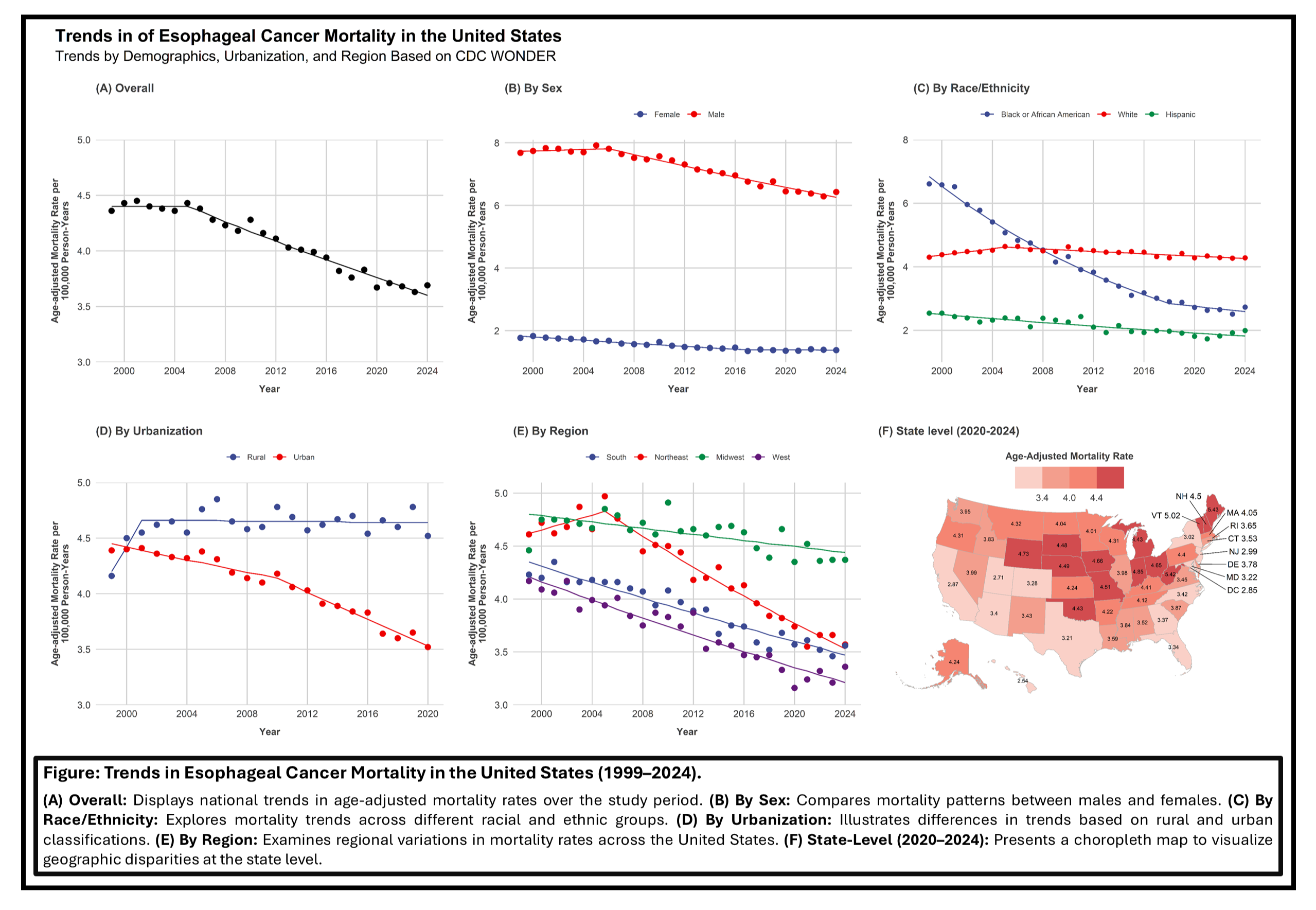Sunday Poster Session
Category: Esophagus
P0654 - Trends in Esophageal Cancer Mortality in the United States (1999-2024): Disparities by Sex, Race/Ethnicity, Region, and Urbanization
Sunday, October 26, 2025
3:30 PM - 7:00 PM PDT
Location: Exhibit Hall

Mohamed B. Elnaggar, MD
Hartford Healthcare
Hartford, CT
Presenting Author(s)
Mohamed A. B. Elnaggar, MD1, Ibrahim Hassan, MD2, Houman Rezaizadeh, MD3
1Hartford Healthcare, Hartford, CT; 2Faculty of Medicine, Suez Canal University, Ismailia, Al Isma'iliyah, Egypt; 3University of Connecticut, Farmington, CT
Introduction: Esophageal carcinoma is the 7th most common cancer worldwide with poor overall survival rates. Impact of treatment advances on national mortality trends remains unclear. Understanding the temporal changes in esophageal cancer mortality is essential for guiding targeted interventions
Methods: Using CDC WONDER database,1999 through 2024 using ICD-10 code (C15) for malignant neoplasm of the esophagus. Annual mortality rates were age-adjusted to the 2000 U.S. standard population and expressed per 100,000 persons. Analyses stratified by sex (male, female), race (Non-Hispanic Black or African American, Non-Hispanic White, Hispanic), U.S. Census region (Northeast, Midwest, South, West), and urbanization status (rural vs. urban). Joinpoint regression identified periods with distinct trends and estimated annual percent changes (APC); the average annual percent change (AAPC) summarized the overall trend
Results: From 1999 to 2024, there were 374,000 deaths from esophageal cancer across a population of over 8 billion. The overall age adjusted mortality rate (AAMR) declined, 4.36 (95% CI: 4.28–4.44) in 1999 to 3.69 (3.63–3.75) in 2024 (AAPC: -0.8%). Sex disparities persisted, with males having significantly higher mortality (6.43 per 100,000) compared to females (1.38 per 100,000) in 2024, though both showed declining trends (AAPC: -0.84% and -1.12%, respectively).
By ethnicity, Black or African American individuals experienced the most pronounced change, from 6.61 to 2.73 (AAPC: -3.82%), with particularly steep declines after 2018 (APC: -1.58%). Hispanic populations saw moderate decreases from 2.54 to 1.99 (AAPC: -1.32%), while White populations showed minimal change from 4.3 to 4.28 (AAPC: -0.05%).
Regionally, the West experienced the greatest decline from 4.17 to 3.36 (AAPC: -1.08%), followed by the Northeast from 4.61 to 3.57 (AAPC: -1.07%), the South from 4.23 to 3.56 (AAPC: -0.89%), and the Midwest showing the smallest decrease from 4.46 to 4.37 (AAPC: -0.31%). Urban areas decline (AAPC: -1.09%), while rural areas with modest increase from 4.16 to 4.52 (AAPC: 0.48%)
Discussion: Mortality due to esophageal cancer in the U.S. has declined modestly from 1999 to 2024, The most significant improvements occurred among African American, while rural areas showed increases in mortality rates. Persistent disparities by sex, ethnicity, and urbanization highlight the need for targeted prevention strategies and improved access to specialized care, particularly in rural settings

Figure: Trends in Esophageal Cancer Mortality in the United States by Demographics, Urbanization and Region based on CDC Wonder database
Disclosures:
Mohamed A. Elnaggar indicated no relevant financial relationships.
Ibrahim Hassan indicated no relevant financial relationships.
Houman Rezaizadeh: AstraZeneca – Wife is employee there, Stock Options, Stock-publicly held company(excluding mutual/index funds). Bristol Meyers Squibb – Grant/Research Support. Celgene – Grant/Research Support. CellDex Therapeutics – Grant/Research Support. Cryoscope medical – Grant/Research Support. Regeneron – Advisor or Review Panel Member, Advisory Committee/Board Member, Consultant, Grant/Research Support, Speakers Bureau. Sanofi – Advisor or Review Panel Member, Advisory Committee/Board Member, Consultant, Grant/Research Support, Speakers Bureau. Skope Inc – Consultant, Intellectual Property/Patents, Stock Options, Stock-privately held company.
Mohamed A. B. Elnaggar, MD1, Ibrahim Hassan, MD2, Houman Rezaizadeh, MD3. P0654 - Trends in Esophageal Cancer Mortality in the United States (1999-2024): Disparities by Sex, Race/Ethnicity, Region, and Urbanization, ACG 2025 Annual Scientific Meeting Abstracts. Phoenix, AZ: American College of Gastroenterology.
1Hartford Healthcare, Hartford, CT; 2Faculty of Medicine, Suez Canal University, Ismailia, Al Isma'iliyah, Egypt; 3University of Connecticut, Farmington, CT
Introduction: Esophageal carcinoma is the 7th most common cancer worldwide with poor overall survival rates. Impact of treatment advances on national mortality trends remains unclear. Understanding the temporal changes in esophageal cancer mortality is essential for guiding targeted interventions
Methods: Using CDC WONDER database,1999 through 2024 using ICD-10 code (C15) for malignant neoplasm of the esophagus. Annual mortality rates were age-adjusted to the 2000 U.S. standard population and expressed per 100,000 persons. Analyses stratified by sex (male, female), race (Non-Hispanic Black or African American, Non-Hispanic White, Hispanic), U.S. Census region (Northeast, Midwest, South, West), and urbanization status (rural vs. urban). Joinpoint regression identified periods with distinct trends and estimated annual percent changes (APC); the average annual percent change (AAPC) summarized the overall trend
Results: From 1999 to 2024, there were 374,000 deaths from esophageal cancer across a population of over 8 billion. The overall age adjusted mortality rate (AAMR) declined, 4.36 (95% CI: 4.28–4.44) in 1999 to 3.69 (3.63–3.75) in 2024 (AAPC: -0.8%). Sex disparities persisted, with males having significantly higher mortality (6.43 per 100,000) compared to females (1.38 per 100,000) in 2024, though both showed declining trends (AAPC: -0.84% and -1.12%, respectively).
By ethnicity, Black or African American individuals experienced the most pronounced change, from 6.61 to 2.73 (AAPC: -3.82%), with particularly steep declines after 2018 (APC: -1.58%). Hispanic populations saw moderate decreases from 2.54 to 1.99 (AAPC: -1.32%), while White populations showed minimal change from 4.3 to 4.28 (AAPC: -0.05%).
Regionally, the West experienced the greatest decline from 4.17 to 3.36 (AAPC: -1.08%), followed by the Northeast from 4.61 to 3.57 (AAPC: -1.07%), the South from 4.23 to 3.56 (AAPC: -0.89%), and the Midwest showing the smallest decrease from 4.46 to 4.37 (AAPC: -0.31%). Urban areas decline (AAPC: -1.09%), while rural areas with modest increase from 4.16 to 4.52 (AAPC: 0.48%)
Discussion: Mortality due to esophageal cancer in the U.S. has declined modestly from 1999 to 2024, The most significant improvements occurred among African American, while rural areas showed increases in mortality rates. Persistent disparities by sex, ethnicity, and urbanization highlight the need for targeted prevention strategies and improved access to specialized care, particularly in rural settings

Figure: Trends in Esophageal Cancer Mortality in the United States by Demographics, Urbanization and Region based on CDC Wonder database
Disclosures:
Mohamed A. Elnaggar indicated no relevant financial relationships.
Ibrahim Hassan indicated no relevant financial relationships.
Houman Rezaizadeh: AstraZeneca – Wife is employee there, Stock Options, Stock-publicly held company(excluding mutual/index funds). Bristol Meyers Squibb – Grant/Research Support. Celgene – Grant/Research Support. CellDex Therapeutics – Grant/Research Support. Cryoscope medical – Grant/Research Support. Regeneron – Advisor or Review Panel Member, Advisory Committee/Board Member, Consultant, Grant/Research Support, Speakers Bureau. Sanofi – Advisor or Review Panel Member, Advisory Committee/Board Member, Consultant, Grant/Research Support, Speakers Bureau. Skope Inc – Consultant, Intellectual Property/Patents, Stock Options, Stock-privately held company.
Mohamed A. B. Elnaggar, MD1, Ibrahim Hassan, MD2, Houman Rezaizadeh, MD3. P0654 - Trends in Esophageal Cancer Mortality in the United States (1999-2024): Disparities by Sex, Race/Ethnicity, Region, and Urbanization, ACG 2025 Annual Scientific Meeting Abstracts. Phoenix, AZ: American College of Gastroenterology.
